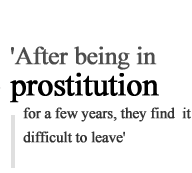|
|
|
|
|
| HOME | NEWS | SPECIALS | |||
|
NEWSLINKS
|
||

 Hariharan's research project was on the socio-economic conditions of the children of sex workers. As his research progressed, he also got involved in a study conducted by the World Health Organisation to identify sex workers in a region where there was no red light area. WHO had selected Madras for its study and Hariharan, along with his colleagues, much to their surprise, identified 3,000 sex workers in Madras. But after the study, they discovered that there were at least 7,000 sex workers in the city even though they could identify only 3,000. It was a revelation to find so many women in a city where there was no red light area. They classified the CSWs (Commercial Sex workers) into three groups.
1. Street workers.
Those who lived with their families constituted the largest number of CSWs. These women operated either with or without the knowledge of their family members. It was found that 1,800 of the 3,000 sex workers in the study had families. After mapping them, they found that these women were not concentrated in any one area but were spread out all over the city. Their research found that 64 per cent of the women were from Andhra Pradesh, 17 per cent from Tamil Nadu, nine per cent from Karnataka and Kerala, and the rest from the other parts of India. They also categorised those who operated brothels into two types: The 'clandestine' ones and the declared ones. The clandestine operators give money to people, from policemen to thugs to commercially run their brothels. But the declared brothels operated more courageously and openly. Many young girls reach the brothels after they are sold in the 'girl bazaar' like commodities. The price for a good-looking girl is Rs. 3,000. Anybody who is fair is good looking, according to brothel owners. They are taken on a month's contract and in their calendar, a month has 37 days. Fifty per cent of the money is paid to the girl's family when she joins the brothel; the rest is given after the 37th day. The brothel owner provides her with breakfast and lunch. As she goes out with clients at night, dinner is taken care of by the clients.
It is found that in this city alone, around 4,000 men visit the 3,000 sex workers daily. If the women are in their twenties, they get around 40 to 50 clients a month. By the time they reach 30, the number of clients recedes. Women above 40 generally do not get clients at all. It is then that they start working as 'suppliers' of young girls to the clients that they know and in return, they get a small commission. When Hariharan discovered that commercial sex workers are treated as untouchables by society, he decided to start an NGO which he named the Indian Community Welfare Organisation to help them lead a decent life. The ICWO's first target was the children of the sex workers. ICWO volunteers managed to convince the women to agree to send their children to boarding schools. The aim was to keep the children away from sexual commerce. The only asset of these emotionally insecure women is their children, and 61 per cent of them have children. Hariharan informed us that five years ago, eight out of ten sex workers wanted their daughters too to be in the trade. Not anymore. Now, not even one per cent of these women say they want their daughters to be in the business. The reason for the change in their attitude is the intervention of NGOs like ICWO who focus mainly on the children. "Our aim is to prevent the children of sex workers from entering the profession. So, we help them put their children into boarding schools. We also encourage these women to save money for their children's education. Earlier, they used to spend all their money on food and liquor, but now with some money in the bank, they feel a little secure," says Hariharan. He remembers a four year old whom he saw near the central station, Madras. The little girl used to tell people, "My mother has gone for night duty. She has gone to meet a client for Rs 400." She didn't know what a client was or what was meant by 'night duty' but it was true that she had lost her innocence at such a tender age. When ICWO tried to persuade the mother to send her little girl to a boarding school, she refused as she had found that policemen were sympathetic to her because of her daughter. Her daughter was her shield from being harassed. The volunteers had to use all their persuasive powers to convince her to send the child to a boarding school. Most sex workers try not to let their children know that they are in a profession called 'prostitution'. Some of them even manage to marry off their daughters but when it comes to their sons, they are at a loss. The boys, when they learn of and understand the nature of the 'job' their mother is doing, take full advantage of the situation. They demand money, drink, they smoke and take to drugs.
In the last ten years, there has been a dramatic change in the behavioural pattern of sex workers and their awareness level, Hariharan said. When he first started working with them, not many knew about contraceptives and they never insisted on using them. From his experience with an NGO, he has found that only 17 per cent of the women used condoms in 1993 but now 87 per cent of them insist their clients use it. "We identify the CSWs and win their confidence before educating them on the dangers that they face if they are not cautious. It is not easy to win their confidence. Later, we use them as peer workers to spread the message among CSWs. Our major focus is on the prevention of AIDS and not on giving alternate employment to these women," Hariharan explained. As the government popularised condoms as a means of family planning and not merely to prevent sexually transmitted diseases, AIDS etc, NGOs find it very difficult to convince women to use condoms for safe sex. Continued: Who are these women? Design: Lynette Menezes |
||
|
HOME |
NEWS |
BUSINESS |
MONEY |
SPORTS |
MOVIES |
CHAT |
INFOTECH |
TRAVEL SINGLES | NEWSLINKS | BOOK SHOP | MUSIC SHOP | GIFT SHOP | HOTEL BOOKINGS AIR/RAIL | WEATHER | MILLENNIUM | BROADBAND | E-CARDS | EDUCATION HOMEPAGES | FREE EMAIL | CONTESTS | FEEDBACK |
||